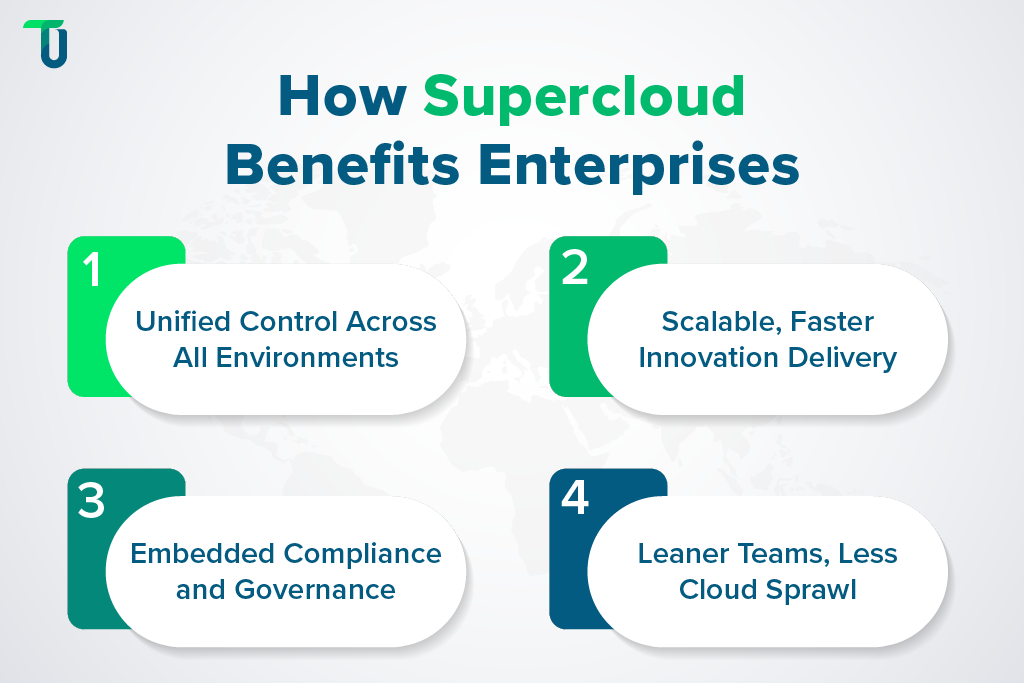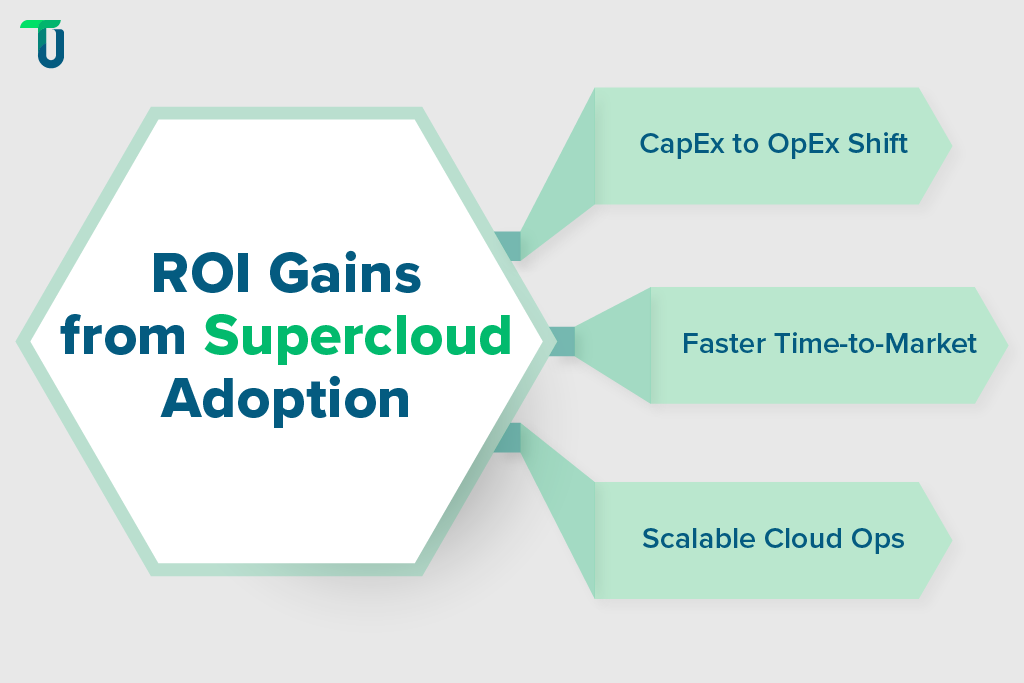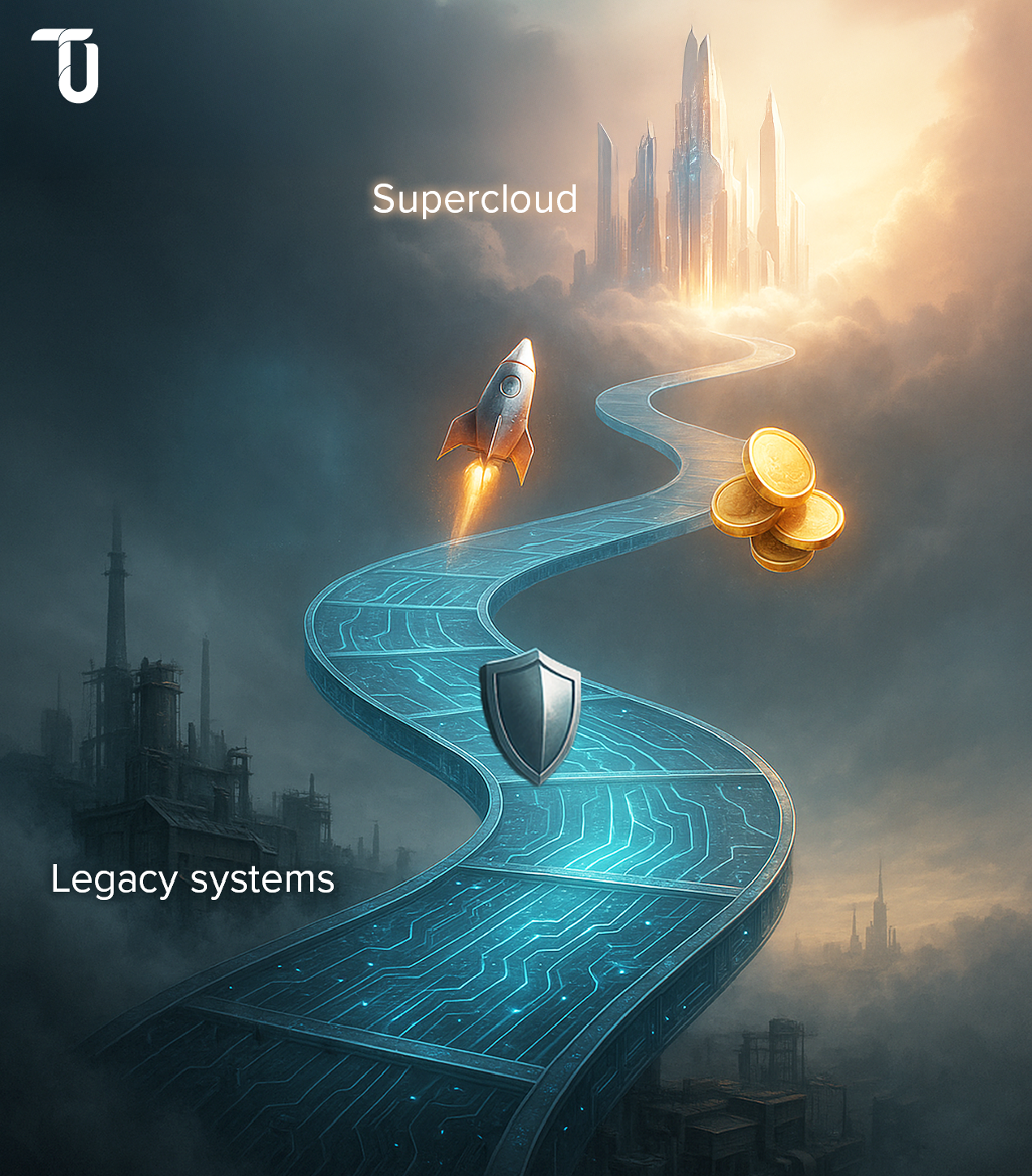Understanding Supercloud and Why Now?
Supercloud refers to an abstraction layer that operates above individual cloud providers. It unifies management, governance, and automation across diverse environments, like public, private, hybrid, and edge.
But unlike traditional multi-cloud, Supercloud isn’t about juggling providers. It’s about building composable, interoperable, and intelligent control planes that eliminate silos and unlock true agility.
Key Reasons Enterprises Need Supercloud Now
- Cloud saturation: Enterprises have 3–5 cloud providers on average, plus legacy systems.
- Macro pressures: Cost containment, talent shortages, and regulatory complexity are at an all-time high.
- Tool sprawl: Cloud integration without consolidation has created governance nightmares.
Supercloud enables organizations to regain control, without stifling innovation.
It’s the connective tissue for a future-ready enterprise.
The Strategic Benefits of Supercloud for Enterprises
For enterprises juggling multiple cloud platforms, legacy systems, and growing compliance pressure, Supercloud offers a way to take back control. It brings structure to the chaos and turns complexity into clarity.
Here’s how it delivers real, measurable impact:

Unified control across multi-cloud and hybrid environments
Supercloud gives you a single pane of glass to manage everything. Whether it’s AWS, Azure, on-prem, or edge, you get visibility, automation, and orchestration across the board. No more silos. No more guesswork.
Improved scalability and speed-to-innovation
With a common control layer, you can scale faster without hitting operational roadblocks. Teams can build, deploy, and iterate across environments without waiting on infrastructure or approvals, similar to how scalable influencer collaboration platforms handle high-performance workloads in influencer marketing software.
Streamlined governance, compliance, and risk management
Policies don’t live in PowerPoints anymore. Supercloud embeds them into the system—automated, auditable, and real-time. This means better control, lower risk, and stronger compliance across all platforms.
Talent efficiency and reduced cloud sprawl
Managing the cloud shouldn’t drain your best minds. Supercloud simplifies operations so your teams spend less time troubleshooting and more time building. It also helps cut down shadow IT and tool sprawl by centralizing access and visibility.
Supercloud isn’t about adding another layer. It’s about simplifying everything that sits beneath it, so your enterprise can move faster, stay secure, and grow smarter.
Ready to leverage the benefits of Supercloud?
Aligning Supercloud with your business goals starts with the right strategy. Talk to our experts to explore what’s possible.
Quantifying the ROI of Supercloud Adoption
Adopting Supercloud is not just a technology upgrade. It’s a financial decision. And like any smart investment, it should pay for itself through cost savings, faster time-to-market, and long-term operational efficiency.
Here’s how enterprises are measuring real returns from Supercloud adoption.

Optimizing CapEx and OpEx with smarter resource management
Traditional IT investments come with high upfront costs and unpredictable spending. Supercloud shifts that model by helping enterprises right-size infrastructure, reduce overprovisioning, and automate cloud resource management. This turns fixed CapEx into flexible OpEx, improving budget control and freeing up funds for innovation.
Accelerating time-to-market and unlocking new revenue
Supercloud enables faster development, and iteration across hybrid and multi-cloud environments. With unified cloud integration and automation in place, product teams move from idea to release in a fraction of the time. The result is quicker market entry and earlier revenue realization.
Improving cloud scalability without adding overhead
With centralized orchestration, enterprises scale workloads across regions and platforms without duplicating operational effort. This drives better utilization of existing assets, lowers maintenance costs, and ensures infrastructure grows with the business.
Real-world impact
Walmart’s Supercloud-like architecture helped save 10–18% on cloud costs annually, while improving deployment velocity and edge performance.
Supercloud is not an added expense. It’s a measurable business enabler. From cost optimization and faster delivery cycles to improved resilience and reduced risk, the financial case is clear.
For CTOs and CIOs looking to tie cloud strategy to boardroom value, Supercloud delivers outcomes that show up on both the balance sheet and the roadmap.
Bonus Read: Supercloud vs. Multicloud vs. Hybrid Cloud— Which One Powers the Right Cloud Strategy?
Risk Mitigation with Supercloud: What CTOs Must Know
Cloud risk isn’t always loud. It often shows up quietly, in the form of vendor lock-in, shadow IT, inconsistent policies, or gaps in disaster recovery. For CTOs navigating high-stakes environments, these risks are more than technical concerns. They’re business liabilities. Supercloud gives you the framework to address these challenges proactively. Here’s how it helps reduce operational and strategic risk at scale.

Eliminating vendor lock-in with architectural flexibility
Supercloud abstracts the control layer from the underlying infrastructure. This means your applications are no longer tightly coupled to a single provider’s stack. You gain the flexibility to run workloads wherever they make the most sense—across AWS, Azure, Google Cloud, or on-premise. This de-risks your cloud investments and puts control back in your hands.
Shutting down shadow IT with centralized visibility
Fragmented tools and unmanaged workloads create blind spots. Supercloud helps you surface them. With a unified dashboard for cloud resource management, you get full visibility across environments. It allows IT to set guardrails, enforce policies, and maintain compliance without slowing down innovation.
Improving security posture with built-in observability and automation
Security shouldn’t be reactive. With Supercloud, you get real-time observability, policy-based access control, and automated remediation across multi-cloud systems. This reduces response times and helps enforce consistent security practices organization-wide.
Strengthening business continuity at cloud scale
Supercloud supports advanced disaster recovery and failover strategies by decoupling infrastructure and services. This enables you to architect for resilience, not just availability. Even in the event of a regional outage or provider failure, your systems stay up, your data stays protected, and your customers stay connected.
For CTOs, Supercloud isn’t just about modernization. It’s about building a safer, smarter, and more stable foundation for the enterprise.
Making the Business Case: How to Pitch Supercloud to the Board
Getting buy-in for Supercloud starts with one simple truth: this isn’t a tech decision. It’s a business move.
For CIOs and CTOs presenting to the board, the conversation needs to go beyond tools and infrastructure. It must tie Supercloud to the organization’s core priorities — growth, risk management, operational efficiency, and future readiness.
Here’s how to frame the business case with clarity and confidence.
Aligning Supercloud with strategic objectives
Boards don’t invest in the cloud. They invest in outcomes. Your pitch should connect the benefits of Supercloud with enterprise-wide goals.
For example:
- If the goal is faster innovation, highlight how Supercloud reduces deployment cycles through unified cloud integration.
- If cost control is key, explain how better cloud resource management optimizes OpEx and reduces waste.
- If resilience is the focus, showcase built-in support for cloud disaster recovery and cloud business continuity at scale.
- Supercloud becomes an enabler. Not just of IT agility, but of business transformation.
Sample business justification framework
Here’s a simple structure to help build your case:
1. Current challenges: Siloed cloud environments, rising infrastructure costs, vendor lock-in, or poor visibility across platforms.
2. Strategic gaps: Limited scalability, inconsistent security, slow response to market shifts.
3. How Supercloud solves them: A unified orchestration layer, automated governance, real-time observability, and cross-cloud mobility.
4. Expected ROI: Highlight enterprise benchmarks, such as up to 30% cost savings through improved cloud resource management and faster time-to-market with reduced downtime.
5. Risk mitigation: Emphasize improvements in compliance, data protection, and overall security posture.
This framework helps position Supercloud not as a "nice to have" but as a critical lever for staying competitive.
Building a phased roadmap for enterprise adoption
A realistic plan matters. Boards are more likely to support Supercloud if there’s a clear, phased approach.
Phase 1: Assess your current cloud landscape, identify fragmentation, and define governance gaps.
Phase 2: Start with one function, like observability or policy automation, then expand to multi-cloud orchestration.
Phase 3: Scale adoption across workloads, business units, and regions. Bring in partners where needed and continuously track value delivered.
This phased adoption helps reduce risk and shows the board that you're not just chasing the next shiny object. You’re building an adaptive cloud foundation that grows with the business.
Also Read: The top use cases of Supercloud across industries like Finance, Healthcare, etc.
Case Studies: Enterprises Realizing Value with Supercloud
Here are three compelling real-world examples of enterprises realizing tangible value by adopting Supercloud-aligned practices or analogous multi-cloud orchestration platforms, showing impressive cost savings, improved efficiency, and risk‑reduction:
Uber: Unified Abstractions Across Multi-Cloud
Uber uses a multi-cloud strategy across GCP, OCI, and on-prem infrastructure. To manage complexity and ensure security, they built internal abstraction layers for secrets management, policy enforcement, and orchestration. These are all core traits of a Supercloud environment.
Key Highlights:
- Security Management: Unified secrets platform across providers
- Cloud Strategy: Optimized for resilience, cost-efficiency, and workload portability
Spotify: Portability and Scale via Google Cloud
Spotify migrated from on-premise infrastructure to a cloud-native architecture built on Google Cloud. By using Kubernetes, BigQuery, and a decentralized DevOps culture, they created a scalable and modular system aligned with Supercloud principles.
Key Highlights:
- Microservices-First: Autonomous squads manage decoupled services
- Portable Infrastructure: GKE powers scalable deployments across services
Goldman Sachs: Policy-Driven Multi-Cloud Resilience
Goldman Sachs adopts a multi-cloud approach to handle a variety of workloads. They use AWS for transaction banking and have developed internal platforms to manage access, entitlements, and uptime while ensuring compliance with regulatory standards.
Key Highlights:
- Multi-Cloud Footprint: Expanding across public clouds for flexibility
- Zero-Downtime Strategy: AWS supports core financial workloads with high availability
Your Supercloud Strategy Needs More Than Tools
Supercloud is not just a technology shift. It’s a mindset shift—one that demands the right strategy, tools, and a partner who’s done it before.
At Tenup Software Services, we help enterprises turn multi-cloud chaos into controlled innovation. Whether you’re just exploring Supercloud or scaling it across global workloads, our comprehensive Cloud services and solutions bring the depth, speed, and clarity you need.
- Deep cloud integration expertise to unify AWS, Azure, GCP, and on-prem environments
- Automation-first approach to simplify governance, security, and compliance
- Battle-tested playbooks for cloud resource management, disaster recovery, and cost optimization
- Engineering excellence across observability, DevOps, and platform modernization
We don’t just implement Supercloud. We help you build the foundation for what’s next—secure, scalable, and future-ready. Let’s turn your cloud strategy into a competitive advantage. Ready to get started? Let’s talk.
Ready to Take Control of Your Cloud Strategy?
Let’s talk about how we can help you simplify operations, cut costs, and build a cloud foundation that scales with your business.
Frequently asked questions
How does Supercloud help avoid vendor lock-in practice?
Supercloud avoids vendor lock-in by creating an abstraction layer that decouples apps from cloud-specific APIs. This allows workloads to move seamlessly across AWS, Azure, GCP, or even on-prem without code rewrites or dependency on proprietary tools. You gain flexibility to choose the best-fit cloud without being locked into one provider’s ecosystem.
Can Supercloud really simplify networking between clouds?
Yes. Supercloud simplifies multi-cloud networking by unifying connectivity and control across providers through tools like Aviatrix and Megaport. It abstracts cloud-specific configs, centralizes routing and security, and ensures seamless app communication—like managing one network, not many.
Is Supercloud just a marketing phrase or a real architectural paradigm?
Supercloud is a legitimate architectural shift, not just jargon. Backed by thought leaders from Cornell, MIT, and the CUBE, it’s defined as a purpose-built abstraction layer across clouds (a “SuperPaaS”) that unifies orchestration, governance, and runtime consistency across diverse environments.
What are the common pitfalls when adopting Supercloud at scale?
Organizations often face governance misalignment, tool sprawl, and integration gaps. Without unified orchestration and automation, managing cross-cloud complexity becomes overwhelming. Inconsistent security and poor visibility can also lead to compliance issues.
How does Supercloud improve security and compliance across environments?
Supercloud enforces consistent security policies, observability, and automation across clouds, minimizing misconfigurations, closing compliance gaps, and reducing regulatory risk through centralized control.
Will Supercloud increase overall cloud spending?
Not necessarily. By optimizing workload placement and minimizing data transfer and overprovisioning, Supercloud can reduce waste and improve ROI, often lowering costs even as cloud usage expands.
How mature is the Supercloud ecosystem today, and who’s building it?
Supercloud is still emerging but rapidly evolving. Key players like Snowflake, Databricks, VMware, Aviatrix, and cloud-native tools like Azure Arc are already delivering core capabilities—unified control, abstraction, and cross-cloud orchestration—bridging multi-cloud complexity today.

